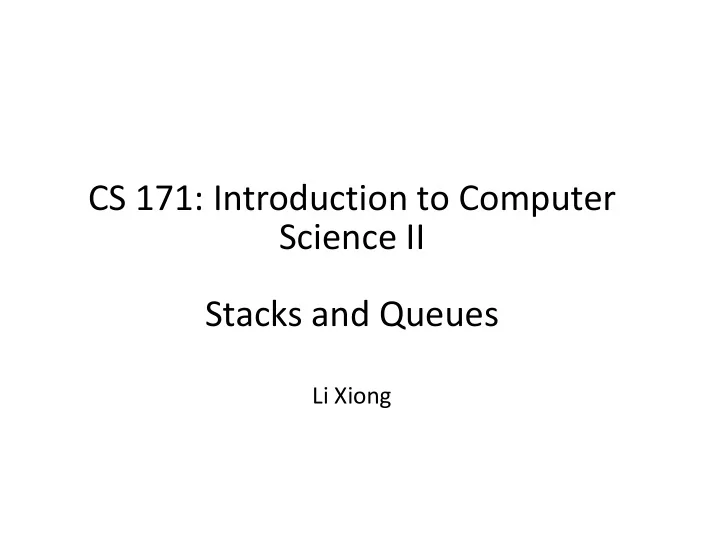

CS 171: Introduction to Computer Science II Stacks and Queues Li Xiong
Announcements/Reminders � Last day to turn in Hw1 with 2 late credits � Hw2 due next Monday � Hw3 to be assigned next Tuesday � Midterm 3/29 Midterm 3/29
Today � Stacks � Operations � Implementation using resizable array � Implementation using generics � Implementation using generics � Applications using stacks � Queues � Operations � Implementation � Applications
Stacks � A stack stores an array of elements but with only two main operations: Push : add an element to the top of the stack Pop : remove the top element of the stack. � Pop always removes the last element that’s � Pop always removes the last element that’s added to the stack. This is called LIFO (Last- In-First-Out).
Stack: Implementations � Stack of strings using fixed-capacity array: FixedCapacityStackOfStrings.java � Generic stack using fixed-capacity array: FixedCapacityStack.java FixedCapacityStack.java � Generic stack using a resizing array: ResizingArrayStack.java � Generic stack using a linked list (next lecture): Stack.java
Stack: Applications � Application 1: Reverse a list of integers � Application 2: Delimiter matching � Application 3: Expression evaluation � Other applications Other applications � Undo/redo history � Browsing history (back button in browser) � Call stack
Application 1: Reverse a list of integers � Reads a sequence of integers, prints them in reverse order
Application 1: Reverse a list of integers � Reads a sequence of integers, prints them in reverse order � Push the integers to a stack one by one � pop and print them one by one � pop and print them one by one Reverse.java
Application 2 – Delimiter Matching � You want to make sure if the parentheses in an mathematical expression is balanced: (w * (x + y) / z – (p / (r – q) ) ) � It may have several different types of � It may have several different types of delimiters: braces{}, brackets[], parentheses(). � Each opening on the left delimiter must be matched by a closing (right) delimiter. � Left delimiters that occur later should be closed before those occurring earlier. ��������� ��
Application 2 – Delimiter Matching � Examples: ��������� ��
Application 2 – Delimiter Matching � Examples: ��������� ��
Application 2 – Delimiter Matching � It’s easy to achieve matching using a stack: � Read characters from the string. � Whenever you see a left (opening) delimiter, push it to the stack. � Whenever you see a right (closing) delimiter, pops the opening delimiter from the stack and match. � If they don’t match, report error. ��������� ��
Application 2 – Delimiter Matching � It’s easy to achieve matching using a stack: � Read characters from the string. � Whenever you see a left (opening) delimiter, push it to the stack. � Whenever you see a right (closing) delimiter, pops the opening delimiter from the stack and match. � If they don’t match, report error. � What happens if the stack is empty when you try to match a closing delimiter? � What happens if the stack is non-empty after all characters are read? ��������� ��
Application 2 – Delimiter Matching � Example: a{b(c[d]e)f} � Code: ~cs171000/share/code/Brackets/brackets.java � Code: ~cs171000/share/code/Brackets/brackets.java � Why does this work? � Delimiters that are opened last must be closed first. � This conforms exactly with the LIFO property of the stack. ��������� ��
������������������� � ��� �� ��!�"� #������$���%����&���������%���' (��� �����"� !� ��) ���!� �� #���*�!� ��)��� ��!�"��&�����' ����� �� +�,���� -#�&�-.�����$���%����&�-//������%����� ,�������,� � �� ,��� #������$�� ,0��-�&�����������%����� , �*�������� � � ���1�12�������������������������������%��3'���� � ���1412 � ���1�12 ���!� ��$��������&���������������������' �,� �& � ���1512�������������������������������%��3'���� � ���1612 � ���1�12 �+��7���!� ��$��8'��3�����������+��� ��������'��39 �+��7���!� ��$��8'��3�����������+��� ��������'��39 � �� ,���( #����!� ��$�����&��������� �������� �+�����##151�::���(7#1�1��;; ���##161�::���(7#141��;; ���##1�1�::���(7#1�1��� !3���'$���$�,������<8,,�,2�</��/<� ��</-�& 5 ��������������������������������,�' ��,��3��'��3 !3���'$���$�,������<8,,�,2�</��/<� ��</-�& �,� �& ��+ ���2���������� �������������,��� , ���,� �,� �& 5����������*���� 5���������+�, ��� ������������9� ����� , ���,��� ���������,������� �+��7���!� ��$��8'��3���� !3���'$���$�,������<8,,�,2�'�����%�,�%�������'���,<�& 5����������������
������������������� � ��� �� ��!�"� #������$���%����&���������%���' (��� �����"� !� ��) ���!� �� #���*�!� ��)��� ��!�"��&�����' ����� �� +�,���� -#�&�-.�����$���%����&�-//������%����� ,�������,� � �� ,��� #������$�� ,0��-�&�����������%����� , �*�������� � � ���1�12�������������������������������%��3'���� � ���1412 � ���1�12 ���!� ��$��������&���������������������' �,� �& � ���1512�������������������������������%��3'���� � ���1612 � ���1�12 �+��7���!� ��$��8'��3�����������+��� ��������'��39 �+��7���!� ��$��8'��3�����������+��� ��������'��39 � �� ,���( #����!� ��$�����&��������� �������� �+�����##151�::���(7#1�1��;; ���##161�::���(7#141��;; ���##1�1�::���(7#1�1��� !3���'$���$�,������<8,,�,2�</��/<� ��</-�& 5 ��������������������������������,�' ��,��3��'��3 !3���'$���$�,������<8,,�,2�</��/<� ��</-�& �,� �& ��+ ���2���������� �������������,��� , ���,� �,� �& 5����������*���� 5���������+�, ��� ������������9� ����� , ���,��� ���������,������� �+��7���!� ��$��8'��3���� !3���'$���$�,������<8,,�,2�'�����%�,�%�������'���,<�& 5����������������
Recommend
More recommend